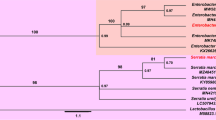Abstract
The larvicidal activity of the pathogen Bacillus thuringiensis H-14 against mosquito larvae of Aedes aegypti (L.) and Culex pipiens L. has been evaluated.
The results showed that the susceptibility of culicine larvae to this pathogen was closely correlated with mosquito species tested and its larval instars. The toxicity curves indicated that the serotype H-14 had a higher pathogenicity against A. aegypti than C. pipiens. LC50 values showed that, for both mosquito species tested, the second instar larvae were more susceptible to the pathogen used than the fourth instar larvae.
Apart from lethal action, larval treatments with B. thuringiensis H-14 led to a decrease in the reproductive potential of female mosquitoes that emerged from these treatments.
Résumé
L’activité de larvicide de pathogen Bacillus thuringiensis H-14 sur les larves des moustiques Aedes aegypti (L.) et sur Culex pipiens L. a étè evaluée.
Les resultats ont montré que la sensibilité de culicine larves envers ce pathogen influait sur ces espècis des moustiques et même sur tous les ages des larves. Les courbes toxicitalles ont montré que le serotype H-14 ont témoigné qu’il fut dl une pathogenique très élevié sue le A. aegypti que le C. pipiens.
Selon les valeurs de LC50 on troursa que les larves 2 éme stade était le plus sensibles au B. thuringiensis que les larves 4 éme stade.
Les résultats ont montré que le traitement de larve par le B. thuringiensis H-14 aboutit à un effet decroissant très visible sur la reproduction potentielle des femelle moustiques émergées parce traitement.
Similar content being viewed by others
References
Al-Fazairy A. A. (1976) Studies on certain pathogens of certain lepidopterous pests. M.Sc. thesis (1976), p. 183. Faculty of Agriculture, University of Alexandria, Alexandria, Egypt.
Garcia R. and Desrochers B. (1979) Toxicity of Bacillus thuringiensis var israelensis to some California mosquitoes under different conditions. Mosquito News 39, 541–544.
Goldberg L. J. and Margalit J. (1977) A bacterial spore demonstrating rapid larvicidal activity against Anopheles sergentii, Uranotaenia unguiculata, Culex univittatus, Aedes aegypti and Culex pipiens. Mosquito News 37, 355–358.
Hall I. M., Arakawa K. Y., Dulmage H. T. and Correa J. A. (1977) The pathogenicity of strains of Bacillus thuringiensis to larvae of Aedes and Culux mosquitoes. Mosquito News 37, 246–251.
Ignoffo C. M. and Gregory B. (1972) Effects of Bacillus thuringiensis ß-exotoxin on larval development, maturation, adult longevity, fecundity and egg viability in several species of lepidoptera. Environ. Ent. 1, 269–272.
Lacey L. A. and Oldacre S. L. (1983) The effect of temperature, larval age, and species of mosquito on the activity of an isolate of Bacillus thuringiensis var darmsta-diensis toxic for mosquito larvae. Mosquito News 43, 176–179.
Litchfield J. T. and Wilcoxon F. (1949) A simplified method of evaluating dose-effect experiments. J. Pharmac. exp. Titer. 96, 99–113.
McGaughey W. H. (1978) Effects of larval age on the susceptibility of almond moths and Indian meal moths to Bacillus thuringiensis. J. econ. Ent. 71, 923–925.
McGaughey W. H. and Kinsinger R. A. (1978) Susceptibility of Angoumois grain moths to Bacillus thuringiensis. J. econ. Ent. 71, 435–436.
Mulla M. S., Darwazeh H. A., Davidson E. W. and Dulmace H. T. (1984) Efficacy and persistence of the microbial agent Bacillus sphaericus against mosquito larvae in organically enriched habitats. Mosquito News 44, 166–173.
Shadduck J. (1980) Bacillus thuringiensis serotype H-14 maximum challenge and eye irritation safety tests in mammals. Mimeographed document WHO/VBC/80. 763.
Author information
Authors and Affiliations
Rights and permissions
About this article
Cite this article
Saleh, M.S. Larvicidal Activity of Bacillus Thuringiensis Serotype H-14 Against Mosquito Larvae. Int J Trop Insect Sci 6, 617–620 (1985). https://doi.org/10.1017/S1742758400009218
Received:
Revised:
Published:
Issue Date:
DOI: https://doi.org/10.1017/S1742758400009218



